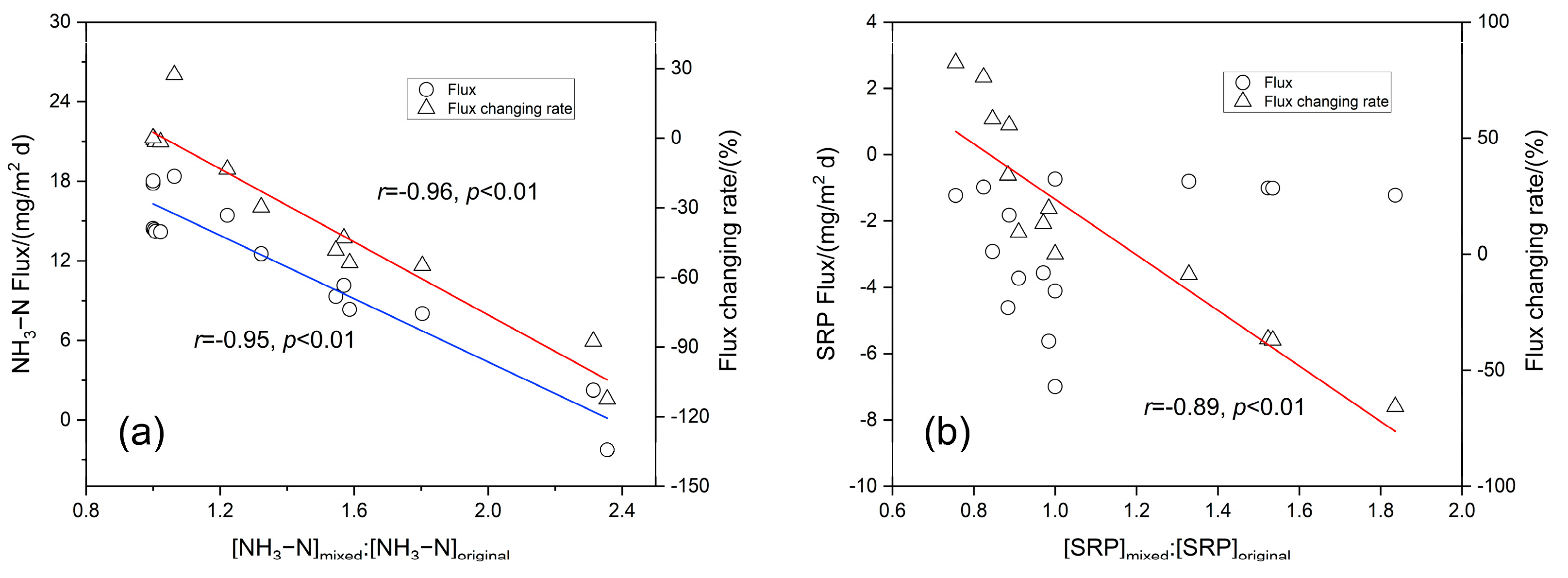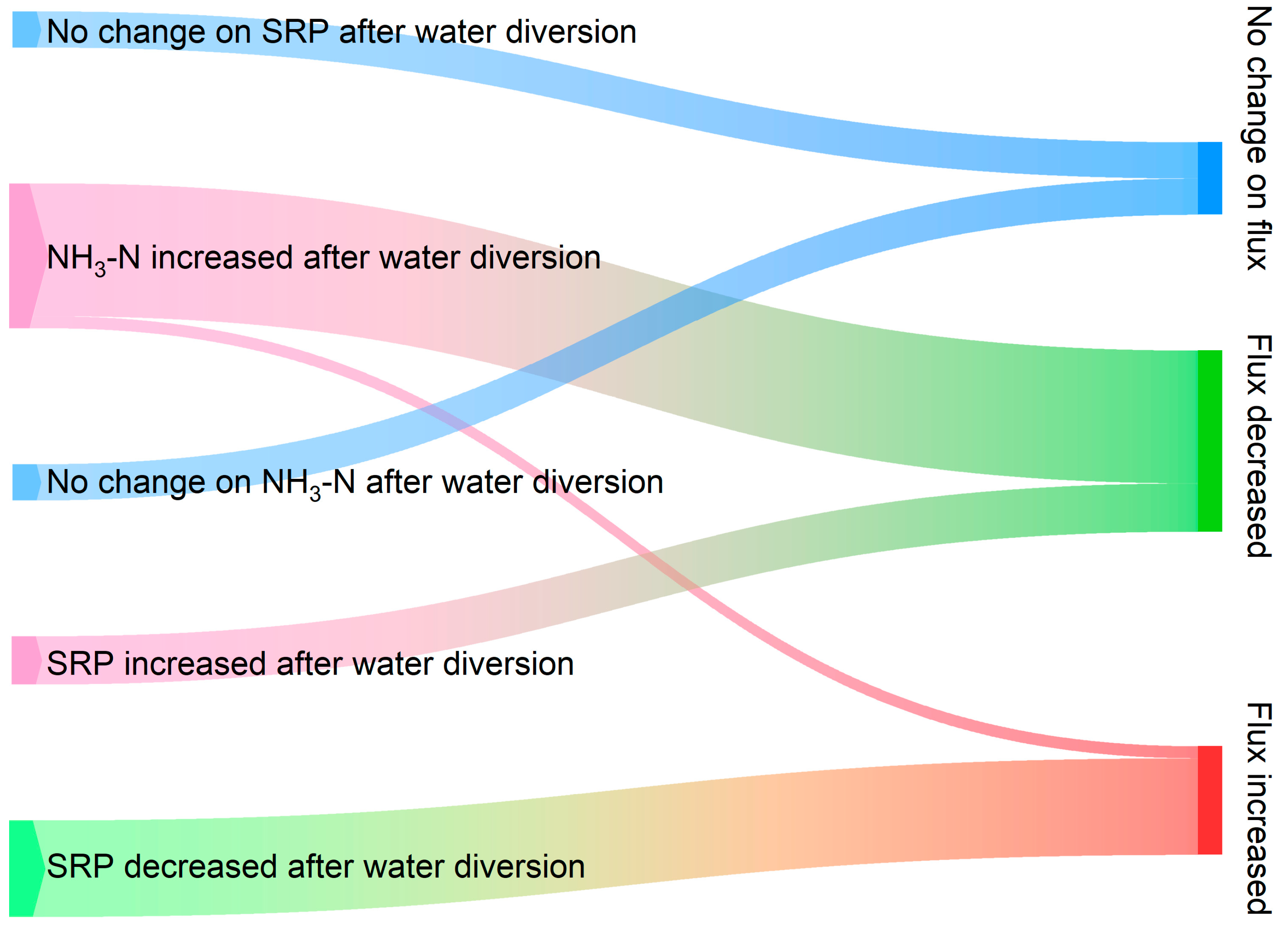Effects of Ecological Water Diversion on Internal Nitrogen and Phosphorus Release in a Typical Small Shallow Lake in China
Abstract
1. Introduction
2. Materials and Methods
2.1. Sample Area and Collection
2.2. Experimental Design
2.3. Analysis and Detection
2.3.1. Water Body Physical Parameters
2.3.2. Water Body Chemical Parameters
2.3.3. Data Processing and Statistical Analysis
3. Results
3.1. Basic Physicochemical Characteristics of Water Bodies
3.2. Static Release
4. Discussion
5. Conclusions
Supplementary Materials
Author Contributions
Funding
Data Availability Statement
Acknowledgments
Conflicts of Interest
References
- Zhai, S.; Hu, W.; Zhu, Z. Ecological impacts of water transfers on Lake Taihu from the Yangtze River, China. Ecol. Eng. 2010, 36, 406–420. [Google Scholar] [CrossRef]
- Welch, E.B.; Barbiero, R.P.; Bouchard, D.; Jones, C.A. Lake trophic state change and constant algal composition following dilution and diversion. Ecol. Eng. 1992, 1, 173–197. [Google Scholar] [CrossRef]
- Liu, Z.J.; Xiao, Q.T.; Hu, Z.H.; Zhang, M.; Wang, W.; Xiao, W. Effects of water diversion from Yangtze River to Lake Taihu on N2O flux in Gonghu Bay, Lake Taihu. China Environ. Sci. 2020, 40, 5229–5236. [Google Scholar] [CrossRef]
- Smit, J.T.; Steinman, A.D. Wetland Sediment Phosphorus Flux in Response to Proposed Hydrologic Reconnection and Warming. Wetlands 2015, 35, 655–665. [Google Scholar] [CrossRef]
- Ge, L.T. The construction of transboundary water pollution prevention and control model of river basin from the perspective of collaborative management—A case study in Water Pollution Prevention and Control in Luanhe-Tianjin Water Diversion Project. China Rural. Water Hydropower 2018, 2018, 60–63. [Google Scholar] [CrossRef]
- Chen, G.Y.; Li, W.; Wang, J.; Lu, F.; Zhao, Y. Progress on Eco-compensation Mechanism Pilot Between Upstream and Downstream of Luanhe River. Environ. Prot. 2017, 45, 24–27. [Google Scholar] [CrossRef]
- Lu, H.M.; Zou, Y.; Feng, H.L. Analysis and inspiration of ecological and environmental impacts of typical water diversion projects at home and abroad. Water Resour. Plan. Des. 2018, 2018, 88–92, 166. [Google Scholar] [CrossRef]
- Zhou, X.P.; Zhai, S.H.; Yuan, L. Influences of water diversion from Yangtze River to Taihu Lake on water quality of Taihu Lake between 2007 and 2008. Water Resour. Prot. 2010, 26, 40–43. [Google Scholar] [CrossRef]
- Lane, R.R.; Day, J.W.; Kemp, G.P.; Demcheck, D.K. The 1994 experimental opening of the Bonnet Carre Spillway to divert Mississippi River water into Lake Pontchartrain, Louisiana. Ecol. Eng. 2001, 17, 411–422. [Google Scholar] [CrossRef]
- Sun, K.Y.; Niu, Z.R.; Wang, J.W.; Zhang, X.Y. Optimal allocation of water resources from Datong River-to-Qinwangchuan Basin Water Diversion Project addressing water supply object transformation. J. Water Resour. Water Eng. 2023, 34, 93–100. [Google Scholar]
- Wu, Y.Y. Application of water ecological facilities in engineering design of transfering water from Datong river to Huangshui river. Yellow River 2020, 42, 67–68. [Google Scholar]
- Mao, J.Z.; Sun, Y.L.; He, K.D.; Kong, G.F.; Yang, Z.L. Study of water environment improvement effect by Niulan River-Dianchi Lake Water Supplement Project in Waihai area of Dianchi Lake. Water Resources Protection. 2017, 33, 47–51. [Google Scholar] [CrossRef]
- Hosper, H.; Meyer, M.-L. Control of phosphorus loading and flushing as restoration methods for Lake Veluwe, The Netherlands. Hydrobiol. Bull. 1986, 20, 183–194. [Google Scholar] [CrossRef]
- Amano, Y.; Sakai, Y.; Sekiya, T.; Takeya, K.; Taki, K.; Machida, M. Effect of phosphorus fluctuation caused by river water dilution in eutrophic lake on competition between blue-green alga Microcystis aeruginosa and diatom Cyclotella sp. J. Environ. Sci. 2010, 22, 1666–1673. [Google Scholar] [CrossRef]
- Zhang, L.L.; Chen, L.; Guo, X.F.; Gu, M. Economic analysis of water transfer and security of drinking water in water-scarce cities. Water Wastewater Eng. 2018, 54, 49–52. [Google Scholar] [CrossRef]
- Li, Y.; Acharya, K.; Yu, Z. Modeling impacts of Yangtze River water transfer on water ages in Lake Taihu, China. Ecol. Eng. 2011, 37, 325–334. [Google Scholar] [CrossRef]
- Lu, X.; Wu, S.; Zhang, Y.; Dai, J.; Li, D. Progress of ecology and environment effect of water diversion project. J. Water Resour. Water Eng. 2015, 26, 38–45. [Google Scholar]
- Hu, L.; Hu, W.; Zhai, S.; Wu, H. Effects on water quality following water transfer in Lake Taihu, China. Ecol. Eng. 2009, 36, 471–481. [Google Scholar] [CrossRef]
- Wei, Z.; Zongpu, X.; Yuanming, Z.; Shuhua, Z.; Ganyu, F.; Ruochen, W.; Huaimin, C.; Siyuan, H.; Shuai, Z.; Ya, Z. Effect of water diversion from the Yangtze River to Lake Taihu on total phosphorus rebound after 2016. J. Lake Sci. 2020, 32, 1432–1445. [Google Scholar] [CrossRef]
- Nie, X.; Lin, Z.W.; Gu, J.G.; Han, B.P. Phosphorus fractions and their release from sediments of middle and small sized reservoirs for drinking water in the south of China. Ecol. Environ. Sci. 2008, 3, 903–908. [Google Scholar] [CrossRef]
- Tendaupenyu, P.; Magadza, C.H.D. Nutrient concentrations in the surface sediments of Lake Chivero, Zimbabwe: A shallow, hypereutrophic, subtropical artificial lake. Lakes Reserv. Res. Manag. 2017, 22, 297–309. [Google Scholar] [CrossRef]
- Schindler, D.W.; Carpenter, S.R.; Chapra, S.C.; Hecky, R.E.; Orihel, D.M. Reducing Phosphorus to Curb Lake Eutrophication is a Success. Environ. Sci. Technol. 2016, 50, 8923–8929. [Google Scholar] [CrossRef]
- Wang, Y.; Jiang, X.; Li, Y.; Wang, S. Spatial and Temporal Distribution of Nitrogen and Phosphorus and Nutritional Characteristics of Water in Dongting Lake. Res. Environ. Sci. 2014, 27, 484–491. [Google Scholar] [CrossRef]
- Li, Y.B.; Kuang, S.; Wang, Z.Y.; Shen, Q.S.; Wang, Y.D.; Kang, D.J. Characteristics and significance of nitrogen, phosphorus and oxygen transportation at the sediment-water interface in east Lake Chaohu. J. Lake Sci. 2020, 32, 688–700. [Google Scholar] [CrossRef]
- Liu, C.; Zhong, J.; Wang, J.; Zhang, L.; Fan, C. Fifteen-year study of environmental dredging effect on variation of nitrogen and phosphorus exchange across the sediment-water interface of an urban lake. Environ. Pollut. 2016, 219, 639–648. [Google Scholar] [CrossRef]
- Editorial Committee of “Determination Methods for Examination of Water and Wastewater”, State Environmental Protection Administration. Determination Methods for Examination of Water and Wastewater, 4th ed.; Monographs; China Environmental Press: Beijing, China, 2002. [Google Scholar]
- GB 3838-2002; Surface Water Environmental Quality Standards. National Environmental Protection Agency. China Standard Press: Beijing, China, 2002.
- Yao, J.; Wang, G.; Xue, B.; Wang, P.; Hao, F.; Xie, G.; Peng, Y. Assessment of lake eutrophication using a novel multidimensional similarity cloud model. J. Environ. Manag. 2019, 248, 109259. [Google Scholar] [CrossRef]
- Zhang, T.-N.; Zhou, S.-L.; Chen, Z.-Y.; Zhang, Z.-W.; Sun, Y.; Yao, B.; Cui, J.-S.; Li, Z.-X.; Luo, X. Analysis of Water Quality and Exchange Flux of Interstitial Water-Overlying Water in Sediments of Baiyangdian Entrance Area in Summer. Environ. Sci. 2021, 42, 3176–3185. [Google Scholar] [CrossRef]
- Li, Y.B. Research on Characteristics and Controlling of Sediment Internal Phosphorous Release from a Small Urban Shallow Lake. Master’s Thesis, Fuzhou University, Fuzhou, China, 2020. [Google Scholar] [CrossRef]
- Hu, W.; Lo, W.; Chua, H.; Sin, S.; Yu, P. Nutrient release and sediment oxygen demand in a eutrophic land-locked embayment in Hong Kong. Environ. Int. 2001, 26, 369–375. [Google Scholar] [CrossRef]
- Zhu, Y.Y.; Jin, X.; Meng, X.; Zhang, C.; Tang, W.Z.; Shan, B.Q.; Zhao, Y. Study on ammonia nitrogen release flux in the sediment-water interface of Baiyangdian Lake. Acta Sci. Circumstantiae 2018, 38, 2435–2444. [Google Scholar] [CrossRef]
- Cui, H.F.; Chen, S.Y.; Yang, C.H.; YANG, C.H.; Tang, W.J.; Yin, P.; Yin, H.B. Internal Pollution and Release Characteristics of Bottom Sediments of Hengshan Reservoir in Yixing City. Environ. Sci. 2020, 41, 5400–5409. [Google Scholar] [CrossRef]
- Portielje, R.; Lijklema, L. Estimation of sediment–water exchange of solutes in Lake Veluwe, The Netherlands. Water Res. 1999, 33, 279–285. [Google Scholar] [CrossRef]
- Liu, J.; Zheng, X.L.; Chen, L.; Wu, C.C. Study on flux and release law of nitrogen and phosphorus of sediment in reservoir. J. Hydraul. Eng. 2012, 43, 339–343. [Google Scholar] [CrossRef]





| Sampling Site | DO (mg/L) | pH | ORP (mV) | EC (mS/cm) | TDS (g/L) | Turbidity (NTU) | Salinity (%) |
|---|---|---|---|---|---|---|---|
| WSD1 | 11.23 | 8.35 | 73 | 0.397 | 0.243 | 36.6 | 0.02 |
| WSD2 | 13.32 | 8.22 | 79 | 0.341 | 0.207 | 31.4 | 0.02 |
| WSD3 | 10.54 | 7.62 | 81 | 0.284 | 0.171 | 17.8 | 0.01 |
| Wangyu River | 12.45 | 6.94 | 285 | 0.257 | 0.167 | 31.1 | 0.01 |
Disclaimer/Publisher’s Note: The statements, opinions and data contained in all publications are solely those of the individual author(s) and contributor(s) and not of MDPI and/or the editor(s). MDPI and/or the editor(s) disclaim responsibility for any injury to people or property resulting from any ideas, methods, instructions or products referred to in the content. |
© 2024 by the authors. Licensee MDPI, Basel, Switzerland. This article is an open access article distributed under the terms and conditions of the Creative Commons Attribution (CC BY) license (https://creativecommons.org/licenses/by/4.0/).
Share and Cite
Chen, H.; Li, Y.; Wu, A.; Wang, Y.; Zhao, Y.; Wang, G.; Han, C.; Shen, Q. Effects of Ecological Water Diversion on Internal Nitrogen and Phosphorus Release in a Typical Small Shallow Lake in China. Water 2024, 16, 1065. https://doi.org/10.3390/w16071065
Chen H, Li Y, Wu A, Wang Y, Zhao Y, Wang G, Han C, Shen Q. Effects of Ecological Water Diversion on Internal Nitrogen and Phosphorus Release in a Typical Small Shallow Lake in China. Water. 2024; 16(7):1065. https://doi.org/10.3390/w16071065
Chicago/Turabian StyleChen, Huaizhi, Yunben Li, Anjie Wu, Yadong Wang, Yanping Zhao, Guoxiang Wang, Chao Han, and Qiushi Shen. 2024. "Effects of Ecological Water Diversion on Internal Nitrogen and Phosphorus Release in a Typical Small Shallow Lake in China" Water 16, no. 7: 1065. https://doi.org/10.3390/w16071065
APA StyleChen, H., Li, Y., Wu, A., Wang, Y., Zhao, Y., Wang, G., Han, C., & Shen, Q. (2024). Effects of Ecological Water Diversion on Internal Nitrogen and Phosphorus Release in a Typical Small Shallow Lake in China. Water, 16(7), 1065. https://doi.org/10.3390/w16071065







